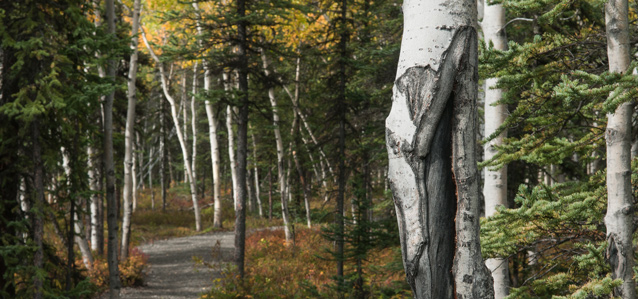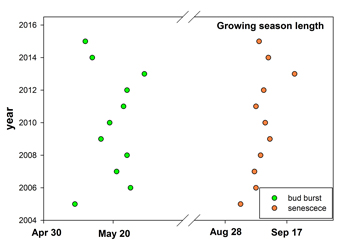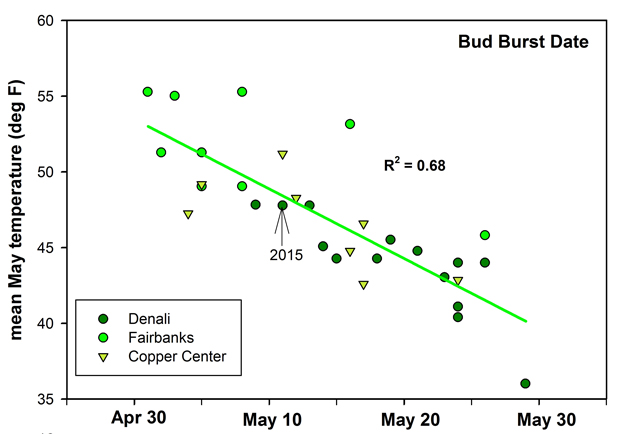
NPS Photo / Tim Rains
Purpose:
The Central Alaska Network (CAKN) monitors phenology because there is evidence from studies around the world that climate change advances the timing of flowering and leaf-out and extends the growing season of plants in northern latitudes and high elevations. A longer growing season has major consequences for plant growth and reproduction, plant-animal interactions like herbivory and pollination, and factors interacting with climate such as carbon exchange and energy exchange. Our objectives are to determine 1) whether the dates of aspen flowering, leaf-out and senescence are changing over time and 2) what climatic variables are the most significant cues to aspen phenology.
Implementation:
The CAKN began monitoring the timing of flowering, leaf-out and senescence in aspen (Populus tremuloides) in Denali in 2005, and started making observations in Fairbanks and Copper Center in the intervening years. Aspen was chosen because it is a circumpolar species studied by other phenology monitoring programs in the country.

Results/Updates:
After 11 years of monitoring phenology in Denali, we have observed no trend in the timing of aspen bud burst or senescence (Fig. 1). Thus, the length of the growing season, which is the time between bud burst and senescence, so far shows no trend over the years we have been monitoring. The length of the growing season, however, varies from year to year and is at least partially dependent on climate, ranging from 105 (in 2006) to 120 days (in 2014; Fig. 1).
We found clear climate drivers of bud burst. Spring temperatures, particularly May and late April temperatures are highly correlated with the bud burst date: the warmer it is in spring, the earlier buds burst. Just within the Denali plots, bud burst occurred up to 20 days earlier with an 11° F increase in mean May temperature (Fig 2). Including the other sites’ data, an increase of 13 degrees in mean May temperature shifted the bud burst date earlier by nearly a month. The driver(s) of senescence is less clear. So far the data show weak negative correlations between senescence and summer precipitation and freezing days in August and early September. That is, leaves turned yellow sooner when summers were particularly rainy and when minimum temperatures frequently dropped below freezing at the end of summer.

Although we do not yet see a trend in the timing of bud burst and leaf yellowing over the years we have been monitoring, we know warm springs lead to early bud bursts. Thus, predictions of warmer spring temperatures suggest earlier bud burst and longer growing seasons for aspens. Indeed, 2015 and 2014 had the second and third earliest bud burst dates (following 2005) and the first and second longest growing seasons observed in Denali over the past 11 years.
Last updated: April 13, 2016
